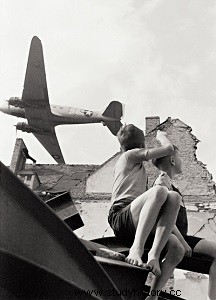
During this period, it was also agreed that, against all odds, the airlift could work very well. Fuel, food and medicine could be flown to Berlin in sufficient quantity to keep the population of the western sectors alive. Finally, during the third period of the blockade, both sides recognized that they were in an impossible situation. The West could hardly hope to ensure West Berlin's survival by airlift indefinitely (although they asserted this) and the Soviets had won no political victory. The general interest demanded that an agreement be reached. Negotiations began in secret in February 1949 and the blockade was lifted in May.
Such was the scheme of the blockade. What were the details? The first serious interruption of traffic to Berlin took place in April 1948, but for a few weeks some communications persisted. Sometimes the Soviets let the trains pass; go, they stopped them. At times it seemed as if the tension was easing and an agreement could be reached. The Westerners were bringing in supplies by air, but there was no question of organizing an airlift on a large scale. If each side, at that time, was looking for a showdown, it did not seem to put much conviction into it. But no one seemed willing to give up either — if only because the question of West Berlin's adoption of the new German currency had yet to be settled.
But in June, it was announced that the motorway bridge over the Elbe, through which western road traffic flowed to Berlin, was to undergo repairs. From there, a whole series of technical skirmishes took place that would quickly put Berlin under siege. At the same time, the pressure on the city government intensified. West Berlin, like Germany during the war, was now fighting on two fronts.
The first battle was about the survival of the population - and victory was only achieved thanks to the determination of the West and the technical possibilities of the U.S. Air Force and the R.A.F. But the second battle was fought to prevent the city from falling under the domination of the Soviet Union - and the victory, this time, depended only on the population. For if the Soviet authorities repeatedly showed that they had no intention of risking an armed conflict with the West, they nevertheless seemed willing to attempt a putsch.
The danger was all the greater because the third deputy mayor of Berlin was a member of the Socialist Unity Party and the Red Army and the police joined forces to undermine the health and morale of his two superiors in order to compel them to resign. They were subjected to interrogations night after night, to smear campaigns, to the continual presence in their offices of Soviet liaison officers. Berlin owes much to Ferdinand Friedensburg, the second deputy mayor, who resisted this pressure for months after the first deputy, in failing health, was forced to leave his post.
At the same time, the real leader of West Berlin, Ernst Reuter, whose election as mayor the previous year had not been recognized by the Soviet commander, was mobilizing the social democrats in order to resist a possible putsch, sometimes giving orders for a surprise rally in the streets where thousands and thousands of Berliners appeared at the first signal. Reuter also made sure that the party organization was ready for any eventuality. During this tragic period, he played a vital role with the population by exalting the spirit of resistance.
In the fall, both battles were clearly won. The airlift was now bringing in sufficient supplies and the danger of a putsch had passed. But neither Reuter nor Friedensburg could prevent the city from being cut in two. From November 1948, Soviets and Communists seemed to recognize their defeat. But while showing their desire to negotiate with the Western powers, they deliberately cut the city in two:first, by expelling the administrative services, one after the other, from the eastern sector – where the central government was located; second, by creating a new government in East Berlin. Eventually, Friedensburg was refused entry to the mayor's office by a smiling Soviet officer. Now there really were two Berlins. One was proclaimed the capital of East Germany; the other remains occupied territory, under the authority of a Western military government but in fact resembles a constituent state of West Germany.
But the blockade continued during the winter and the negotiations, from the start, promised to be difficult. Because at that time, the Soviet authorities used the blockade to delay the establishment of a West Germany. On the record day of the "airlift", nearly 1,400 planes landed in West Berlin. Even during the winter, planes brought more coal than had previously arrived by rail. The average daily delivery included 5,000 tons of coal. In all, 2 or 3 million tons were brought to Berlin by air. Two-thirds were transported by the U.S. Air Force, the rest by the R.A.F. The airlift claimed the lives of 69 people — American and British pilots and German ground personnel.
